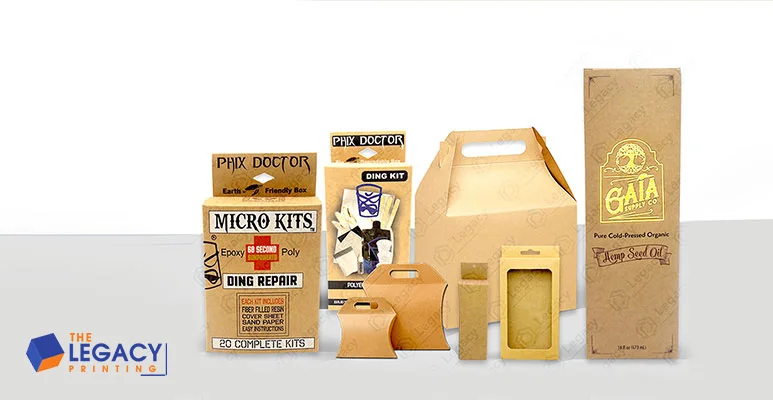What is Kraft Paper
Kraft paper is a material used in the packaging of various items. You can apply it in the manufacturing of encasing that can enclose light bakery goods or even industrial products. Businesses openly rely on Kraft materials because of increased durability, efficiency, and elasticity. The paper sheet is created from virgin and reused chemical pulp and has high flexibility and tear resistance features.
It comes in weights ranging from 30-300gsm and can be ordered in natural brown or bleached white, depending on the needs of the business or manufacturer. Both fully bleached (white) and brown kraft sheets are high-quality, strong, bright, and can tolerate pressure.
The product packaging is worthless without printing, and the item enclosed inside can’t substantially impact the market. Additionally, printing on paper can elegantly enhance the display of your merchandise and make it more appealing to the audience. Getting the kraft material imprinted is easier because it can hold the printed text, labels, or images.
Businesses can also use various colors on the kraft packaging to reinvigorate the look and make it charming for the end-users. Another key aspect distinctive from the others is its environment-friendly nature.
Visit Thelegacyprinting Shop or request a price and tell us more about your project if you’re interested in Kraft box packaging!
How Is Kraft Paper Made?
Kraft paper is created using the Kraft process, which, like other papermaking techniques, entails chemically converting wood into wood pulp. Lignin and cellulose are the two main underlying components of wood. You must remove lignin from cellulose since it does not form excellent paper.
Wood chips are boiled in a “white liquor” of sodium sulfide and hydroxide to achieve this state. The process separates the lignin and cellulose from the solid wood pulp, leaving a “black liquor” behind. The wood chips are now crushed into a pulp and filtered to eliminate bigger fragments. After being rinsed to eliminate any remaining cooking liquors, the pulp can be processed into various paper products.
To achieve the color and appearance quality standards, the pulp must be bleached to the whiteness of 24 percent to 34 percent, and the yellow and red values of the pulp must be kept reasonably steady, i.e., the bleached pulp’s hue must be stable.
Optimizing the pulping process is essential in improving the strength of fine kraft paper. In general, to improve the physical strength, uniformity, and flatness of the paper, the beating degree of the pulp must be increased while retaining its good air permeability and low tightness.
The press production method impacts the paper’s breathability, tightness, and smoothness. The pressing decreases the paper’s porosity, lowering the permeability and suction height while increasing the tightness.
During drying, the paper sheet eliminates humidity and changes the properties of tightness, moisture absorption, airtightness, flatness, or dimension. The drying technique and procedure have a big role in these modifications. High temperature and drying with fast heating are thought to increase the paper’s softness, porosity, absorbency, and air permeability while lowering its tightness, transparency, and mechanical strength.
Types of Kraft Paper
Following are some of the main types of kraft paper rolls available in the market:
Virgin Natural Kraft Paper
The clean and durable fiber composition of virgin natural kraft paper and its inexpensive cost makes it a great choice for heavy-duty applications requiring high tear resistance.
Natural Recycled Kraft Paper
Natural recycled kraft paper is a more ecologically responsible alternative than virgin natural kraft paper. Yet, it still has the strength to do a good job with crates and liners for trays and containers and bottom covers for newspapers.
Colored Kraft Paper
Colored kraft paper comes in almost every hue of the rainbow. Its brilliant colors make it ideal for various creative projects and fun backers for bulletin boards, school materials, scrapbooking, and other similar uses. You should use colored kraft paper if your target market comprises schools, daycares, or art academies.
Is Kraft Paper Recyclable
Yes, you can recycle the kraft paper. It is made from virgin wood pulp and is, therefore, organic. You have the luxury of recycling Kraft paper up to seven times. The recycling of kraft paper is fairly similar to recycling other paper types. The kraft papers are gathered and sifted first to remove impurities or toxins. After being sorted, the papers are sent to a mill, where recycling begins.
Unlike ordinary paper manufacturing and printing, kraft paper goes through a considerably simpler process using fewer chemicals. Recycling includes pulping, washing, screening, deinking, dispersion, kneading, bleaching, water treatment, and waste processing. New paper goods are created after the recycling process.
Recycling kraft paper involves certain hurdles, like the fear of contamination. Often, individuals are unaware of recycling, as seen by how they utilize and dispose of objects.
Oil, filth, scrap steel, and food waste contaminate recycling. Chemical methods are required to remove the majority of pollutants. The biodegradable brown wrapping paper needs to be handled with great care so you can reuse it in the future.
Is Brown Kraft Paper Recyclable
Brown paper is made out of the same basic elements as all other types of paper: wood pulp fiber. The major distinction is in how the wood pulp is transformed into paper.
The Kraft process breaks down the fibers using sodium hydroxide and sodium sulfide. It creates durable paper. Another significant distinction between brown and white paper is that brown paper is not bleached, making it a more environmentally conscious option.
Brown and white papers go through the same recycling process, with the fibers pulped, cleaned, and removed from any inks or other impurities. This pulp can then be dried and pressed to create paper goods in the same manner as virgin materials.
Look for synthetic materials like tape or inks and non-paper coverings like plastic. Brown paper often does not have this coating, although many sparkly or bright sheets have.
Lower Cost of Paper
The cost of wrapping is added to the final price of any product, which impacts how well it fares with the competition in the market. Plastic packaging is more costly than kraft paper packaging. It also has a lower weight than packaging with features like zip closures. The cost of transportation is determined by the weight of the packing, which impacts the ultimate consumer price in kraft paper packaging.
High Strength and Durability
Kraft paper is tough enough to handle complex printing on sophisticated, high-tech equipment. It indicates you have virtually limitless alternatives for creating the printing on your box. It also withstands shipment and increases the enclosed item’s shelf life considerably.
Kraft Paper Uses
We can incorporate kraft material in the packaging to make the product safe and enhance its shelf life. Following are some of the ways through which we can use kraft paper:
Artwork
Apart from its usage in the product packaging, we can also use kraft paper as a canvas. Painters and artists can use it to draw, paint, and make aesthetically appealing artworks. You can get the kraft paper in different colors and be more creative in the drawing. Kids can learn numbers and the alphabet by drawing them on paper.
Protection of Snacks
Food businesses prefer to use kraft because it’s cheap, and they can convey the feel of environmental protection due to its impeccable features. The paper is great at holding the snacks like chips, burgers, wraps, sweets, and much more. You can ask the packaging provider to mold it in a specific shape or size. Furthermore, the business owners can ask the printing enterprise to apply the logo or stickers to create a personalized feel for the target audience.
Wrapping of Gifts
There are no constraints if we speak about the colors of kraft paper. It comes naturally brown; you can also choose colored kraft paper. You can send the items wrapped in kraft paper and adore them with ribbons and aesthetic designs to make them more tempting for the audience. The gifts packed inside the kraft paper can make special occasions more memorable. Because it’s neutral, kraft paper is more favorable to creativity than colorful, textured paper because you can customize and enhance it in whatever you like.
Covering the Floor
During the construction, the wooden floor of the house can be damaged easily. Therefore, the kraft paper is applied to the bottom to protect its surface. Using kraft paper on the floor is common because it acts as a shield and prevents fiberglass from damaging the floor and tiles.
Protection of Books
Keeping the books protected and secured from dust damage is a huge challenge. But kraft paper offers direct assistance as it can be wrapped around the books and as a cover to keep dust and other impurities away. The book’s pages can remain safe as any damage effects don’t penetrate deep inside to affect the book’s condition.

 Cosmetic Display Boxes
Cosmetic Display Boxes
 Cream Boxes
Cream Boxes
 Eye Shadow Boxes
Eye Shadow Boxes
 Eyelash Boxes
Eyelash Boxes
 Eyeliner Boxes
Eyeliner Boxes
 Foundation Boxes
Foundation Boxes
 Hiar Extension Boxes
Hiar Extension Boxes
 Lip Balm Boxes
Lip Balm Boxes
 Lip Gloss Boxes
Lip Gloss Boxes
 Lipstick Boxes
Lipstick Boxes
 Makeup Boxes
Makeup Boxes
 Mascara Boxes
Mascara Boxes
 Nail Polish Boxes
Nail Polish Boxes
 Perfume Boxes
Perfume Boxes
 Scrub Boxes
Scrub Boxes
 Serum Boxes
Serum Boxes
 Bakery Boxes
Bakery Boxes
 Cake Boxes
Cake Boxes
 Candy Boxes
Candy Boxes
 Cereal Boxes
Cereal Boxes
 Chocolate Boxes
Chocolate Boxes
 Coffee Boxes
Coffee Boxes
 Cookie Boxes
Cookie Boxes
 Cup Cake Boxes
Cup Cake Boxes
 Donut Boxes
Donut Boxes
 Macaron Boxes
Macaron Boxes
 Muffin Boxes
Muffin Boxes
 Pastry Boxes
Pastry Boxes
 Popcorn Boxes
Popcorn Boxes
 Snack Boxes
Snack Boxes
 Tea Boxes
Tea Boxes
 Truffle Boxes
Truffle Boxes
 Wine Boxes
Wine Boxes
 Bux Board Packaging
Bux Board Packaging
 Kraft Boxes
Kraft Boxes
 Mailer Boxes
Mailer Boxes
 Bath Bomb Boxes
Bath Bomb Boxes
 Candle Boxes
Candle Boxes
 Cardboard Boxes
Cardboard Boxes
 Corrugated Boxes
Corrugated Boxes
 Die-Cut Boxes
Die-Cut Boxes
 Display Boxes
Display Boxes
 Holographic Boxes
Holographic Boxes
 Medicine Boxes
Medicine Boxes
 Pillow Boxes
Pillow Boxes
 Product Packaging
Product Packaging
 Pyramid Boxes
Pyramid Boxes
 Showcase Boxes
Showcase Boxes
 Soap Boxes
Soap Boxes
 Subscription Boxes
Subscription Boxes
 Tie Boxes
Tie Boxes
 Games Boxes
Games Boxes
 Christmas Boxes
Christmas Boxes
 Favor Boxes
Favor Boxes
 Gable Boxes
Gable Boxes
 Handle Boxes
Handle Boxes
 Ornament Boxes
Ornament Boxes
 Jewellery Boxes
Jewellery Boxes
 Telescoping Rigid Boxes
Telescoping Rigid Boxes
 Textured Boxes
Textured Boxes
 Rigid Gift Boxes
Rigid Gift Boxes


